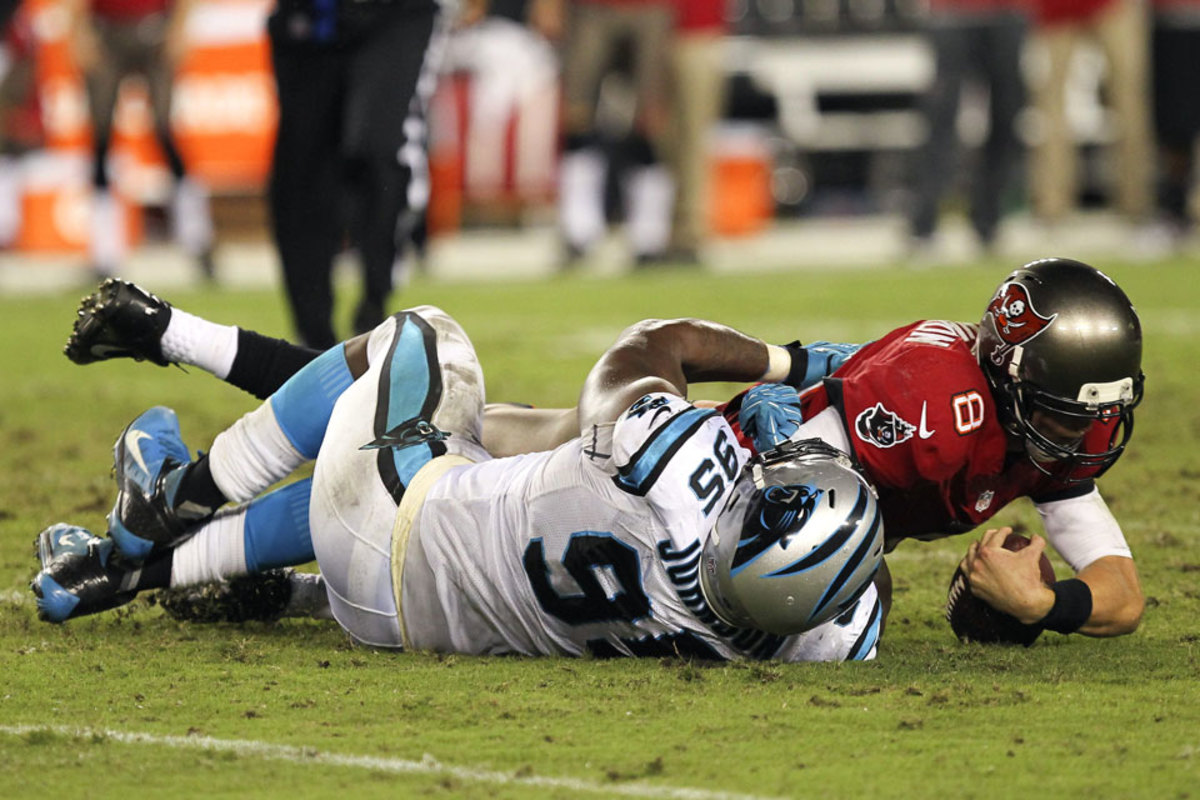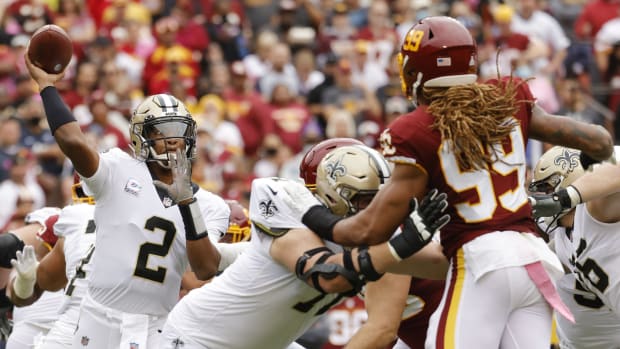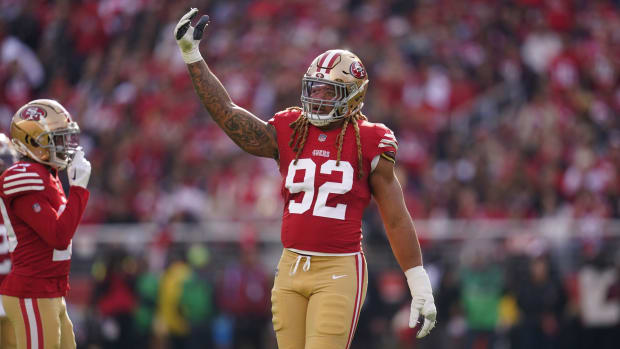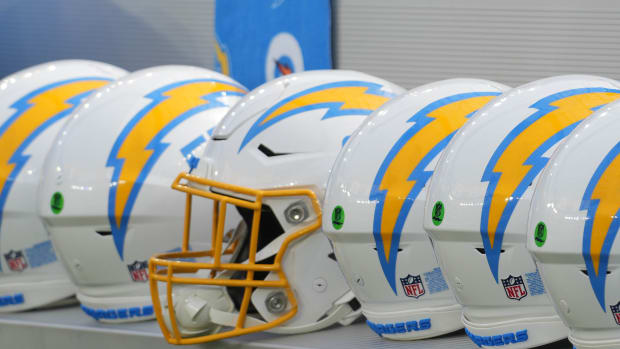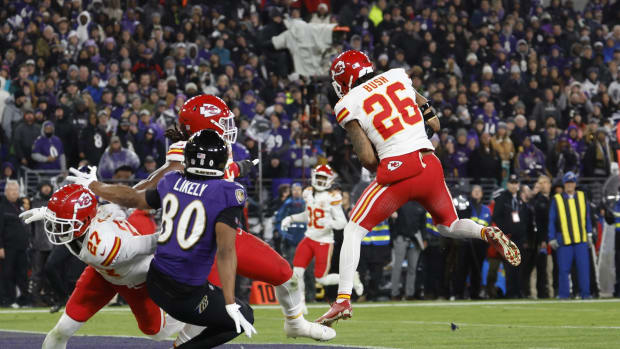Pressure Points: More Than Bits of Real Panther
Panthers defensive end Charles Johnson is far from the prototypical pass rusher who makes a living on the edge, where lean and fast players rule. Yet he thinks his size (6-2, 285) works to his advantage because opposing linemen underestimate his speed.
“When they look at me, they think I’m not fast,” Johnson said this week. “But the first fundamental in pass rush is the get-off, and I pride myself on how I get off the ball.”
No matter where he lined up against the Bucs last week, whether he was at his usual end position or inside playing tackle in passing situations, Johnson used that explosiveness and a variety of pass-rush moves to rack up a league-leading 6.0 MMQB Pressure Points, earning him the Week 8 edge pass rusher award. He had two sacks, drew two holding penalties, had six hurries and another quarterback hit.
Both of Johnson’s sacks resulted from speed moves combined with the all-important handwork (the first came from the end position, the second at tackle).
“When you go on the inside, it’s mostly like third down, I’m always going to use speed there because the (interior offensive linemen) are kind of slower guys and like to jump set you and use quick hands,” Johnson said. “They don’t want you to get that momentum started, so I’m always going to use speed when I get in that three technique. I’m going to try to use that speed and then counter off of that.
“I’m always anticipating hands. That’s probably my best attribute as a pass rusher. I’m going to chop your hands, get your hands down. I don’t like cats getting their hands on me, so it’s all good.”
You can see in the examples below how Johnson, on the first sack, pushed the right hand of tackle Demar Dotson down to gain the edge.
On the second sack, against Davin Joseph, he quickly flipped Joseph's right arm and it was over for quarterback Mike Glennon.
Johnson, who is tied for fifth among edge rushers with at 10.4 rate this season, and bookend tackle Greg Hardy combined for 10.25 points in Week 8. Hardy has really come on this season, and the additions of free agent Dwan Edwards and rookie tackle Star Lotulelei have aided Johnson’s performance as well.
“It’s big,” Johnson said. “Not just Greg but the D-line in general. If one guy is getting doubled, then we’re expecting one guy to win the one-on-one. That’s what I pride myself on this year, winning the one-on-ones when they try to cover up in other spots.”
Unsung edge rusher of Week 8
Rob Ninkovich, New England Patriots
Ninkovich, who received a contract extension from the Patriots this season, is The MMQB’s unsung edge rusher for the second time this year. It might be time we all stop calling Ninkovich one of the league’s most underrated players, and just call him what he is: a darn good football player.
“My mentality is, really, I’m playing to be a better player for myself,” Ninkovich said. “I really can’t look at what anyone else is saying because some people might think I’m way overrated, not a good football player at all. I just focus on what I can do to help my team. That’s why I love being in New England, because I’m valued here for what I can do with this defense. Maybe I wouldn’t be valued at all somewhere else. It goes a long way to being here for five years and learning how they run the defense.”
Jim Rogash/Getty Images
It’s because of the Patriots’ defensive scheme—in which discipline is often the job—that Ninkovich will never have gaudy sack numbers. But look at the totality of his play, and it certainly stands out. Ninkovich had just one sack against the Dolphins—it was in our “easy” category because he wasn’t blocked—but he garnered two sack assists, added five hurries and two quarterback hits. One of the hits caused a big second-half interception, the second time Ninkovich has done that this season.
Ninkovich explained the subtleties of his role in the Patriots’ scheme—and didn’t even touch on the games when he’s first responsible for rerouting a tight end before rushing the passer.
“Me playing on the left side of the line of scrimmage, it’s one of the most important parts for a defensive end as far as keeping leverage on the quarterback,” Ninkovich said. “It’s more important for me to keep the quarterback in the pocket, not let him scramble around than it is to take a shot and just run around the edge.
“A lot of teams don’t really have as much responsibility as far as (their ends) just getting off on the ball; they just want them to get off, get off, get off. For me, I can’t do that because it messes up how our team plays on defense. So my job really is to force the quarterback to make a decision early by getting pressure on him, but not running behind him. That’s one big thing that’s always told to me: never be behind the quarterback, that’s the worst place for a D-lineman to be.
“So my approach is to start early in the game with some bull-rushes just to kind of set him up so they short set me, and then work an inside move to come down even more, and then get outside on him. If you watch any of my games, the first parts of the game, I’m usually more power rushes. And as the offensive line adjusts to how I’m doing that, then I will start working the edges a little bit more.”
Ninkovich showed off his athletic ability and technique when he beat right tackle Jonathan Martin around the edge to hit Ryan Tannehill’s arm on his interception with 13:14 remaining in the game. Ninkovich first went into Martin’s chest, dipped to keep Martin from getting his arms extended, planted his outside foot and then made a beeline toward Tannehill. (See photos, left to right, top to bottom.)
Top interior rushers of Week 8
Terrance Knighton, Denver Broncos
Mike Daniels, Green Bay Packers
The Broncos had been light on the interior of their defensive line the past few seasons, so they signed Knighton to a free agent contract in March believing he could anchor the unit because he had performed well for the struggling Jaguars. But at some point during the offseason, Knighton got too comfortable after signing a two-year deal worth $5 million (including a half-million dollar signing bonus) and the feeling within the organization was that he was too heavy (he’s currently listed at 6-3, 335). It got to the point that after the Broncos were shellacked by the Seahawks in the second exhibition game, 40-10, something was said to Knighton. Basically, it was, “We’re all working our butts here to be at our best. You need to do your part.”
Knighton bought in, and over the next three weeks before the opener against the Ravens he lost 25 pounds. It made a huge difference and Knighton’s contributions have become invaluable to the Broncos. Against the Redskins last Sunday, he had one sack, one sack assist, drew a hold, added two hurries and two hits. In total, his 4.0 pressure points tied the Packers’ Mike Daniels for the Week 8 top interior rusher award.
“I didn’t want to be that guy (letting others down),” Knighton said. “I wanted to be on the field as much as I can, so I just got myself into better shape.”
Even after the performance he had, Knighton doesn’t consider himself to be a top pass rusher.
“I think I have the ability to rush the passer, I wouldn’t consider myself an elite pass rusher; I consider myself an elite run stuffer,” Knighton said. “To be successful in this league, you have to be able to do both. That was one of the emphases we had in the offseason, with getting push up the middle.”
Daniels, a fourth-round pick for the Packers in 2012, has been a huge addition to their pass rush. He posted two unassisted sacks and three hurries against the Vikings. Daniels, at 6-0 and 300 pounds, has been able to use his unusual frame to his advantage as a nickel interior pass rusher.
“He’s got a really good combination of strength and punch and quickness to get off a block and go close the gap,” Packers defensive coordinator Dom Capers said this week. “That’s what you have to do. You’ve got to be able to make your move on a guy. Sometimes you power him and move him back. Mike has a little bit of an advantage because he has a leverage advantage on most offensive linemen he’s playing.”
Unsung interior rusher of Week 8
Dontari Poe, Kansas City Chiefs
The impressive nosetackle takes this award for the second time this season. He didn’t get a sack against the Browns, but he had a sack assist and six hurries from his interior spot. Poe has been a big reason why the Chiefs’ defense leads in both total pressure points (125) and rate (34.9). His ability to command double teams, and push the pocket when he’s singled up has created opportunities for others. Poe leads all rushers regardless of position with five “sack assists,” which The MMQB tallies to credit players who create sacks for other players.
Week 8 Team Defensive Pressure Points
2013 Cumulative Pressure Points
2013 Offensive Lines
Our Methodology
One of biggest indicators of success for NFL defensive coaches is the ability to affect the quarterback.
Sure, that means sacks, which are an official NFL statistic. And quarterback hits, which are also tallied in press boxes. But affecting the quarterback, making him feel pressure, has several other factors, most of which aren’t officially tallied (though NFL teams do them internally).
We at The MMQB thought long and hard about finding a better way to evaluate quarterback pressure, both from individual and team standpoints. We’ve developed our own formula, which we think will highlight players who aren’t getting the glory stats (sacks) but are still affecting the quarterback just as much.
The two statistics that we’ll be tabulating are sack assists and drawn holds. The latter is self-explanatory. Pass rushers are sometimes held by offensive lineman before they can sack the quarterback. Those plays aren’t official plays for the NFL. But they can be nearly as damaging. It’s a 10-yard foul, although there is no loss of down.
A sack assist is given to a player who allows a teammate to get a sack. You see it all the time. One player comes flying at a quarterback, causing him to bolt, and the QB winds up in the arms of a different defender. Sometimes the sacker didn’t do very much, yet he still gets credit for the sack. The player who actually caused the sack gets nothing. We’re going to change that.
Here’s how the formula works.
Sacks
Because not all sacks are created equally, we have divided up sacks into three categories: solo, assisted and easy.
Solo sack (1.25 points): For the player who beats a blocker and gets the sack on his own. These are the real sack masters; they should be rewarded for their standout individual effort.
Assisted sack (.75 points): Given to the player who officially receives a sack but had help from a teammate in taking the quarterback down.
Easy sack (.75 points): An official sack that falls into one of the following categories: coverage sack (quarterback held the ball longer than 3.3 seconds because the coverage was so good); unblocked, usually because of a schemed blitz; offensive miscue, such as the quarterback tripping after getting stepped on by an offensive lineman; or garbage-time sack, which we have defined as a sack when the offense is trailing by more than two scores with four minutes or less remaining in the game.
Sack assist (.5 points): As described above, this is when a player aids in the sacking of a quarterback. The official sacker will get an “assisted” or “easy” sack (.75 points), and the disrupter gets a “sack assist.”
Disruptions
These three categories—drawn holds, hurries and hits—are not official statistics, but they’re extremely important. A team can have zero sacks, but if they accumulate hurries or hits, they’re making life extremely uncomfortable for a quarterback. The hurries and hits are shared with us by our friends at ProFootballFocus.com. Our hits and hurries include plays wiped out by penalty.
Drawn hold (.75 points): The player who draws a holding penalty on a pass play. Only tabulated if the penalty results in a “no play.” If there is holding on a sack and the sack counts, there is no drawn hold—although that player could get a sack assist.
Hurry (.5 points): When the actions of a defender causes the quarterback to alter his throw or footwork. This is what defenses call “moving a quarterback off his spot.”
Hit (.5 points): Recorded just after or as the quarterback releases a pass and goes to the ground as a result of contact with a defender.
Pressure Points
edge rushers
interior rushers
by team
































